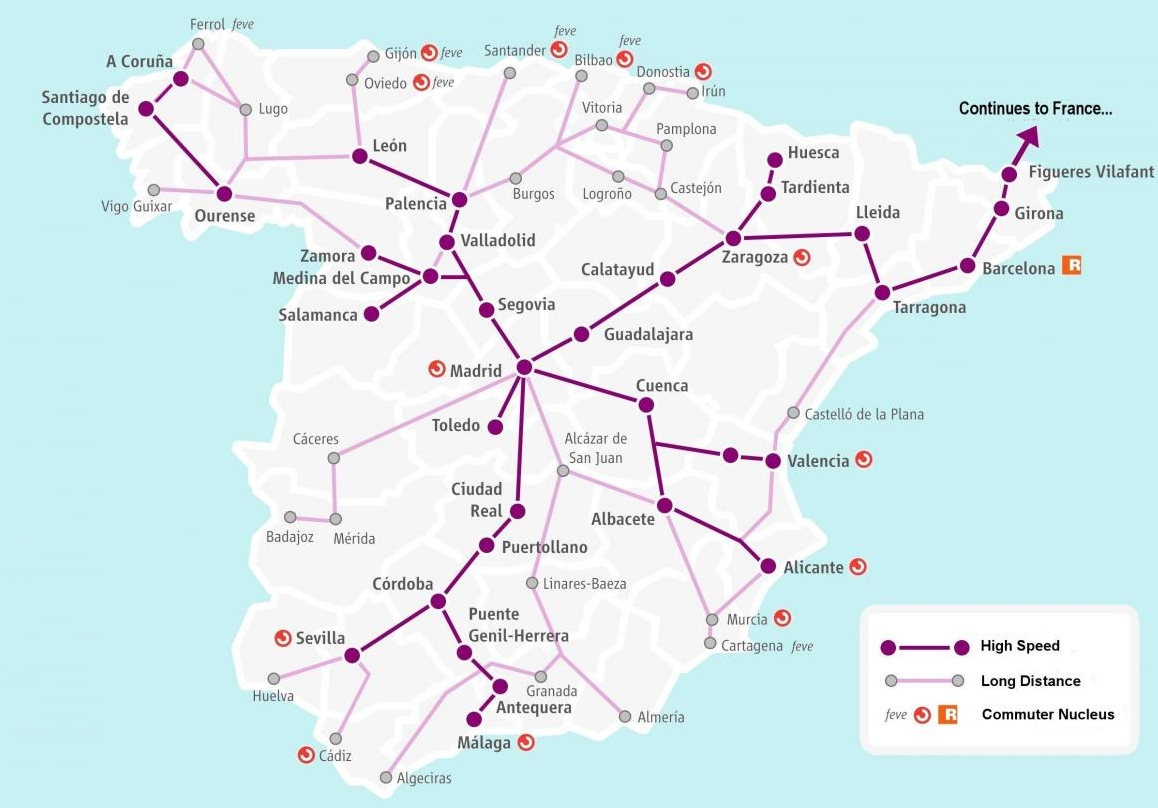There are excellent options for transportationin Spain. In fact, Spain is an easy and economical country to get around, whichever method you choose. Whether you are driving, using public transport, or flying, we have the information you need. Here is our guide to how to get around Spain.
Using A Car In Spain
Driving in Spain
Spain has a well-developed road network, with over 17,000 kilometers of highways and motorways. The main roads are divided into two categories: autopistas and autovías. Autopistas are toll roads, while autovías are free.
Don’t forget that, like most of the world, Spain drives on the right side of the road.
The speed limit on autopistas is 120 kilometers per hour, while the speed limit on autovías is 100 kilometers per hour. In built-up areas, the speed limit is 50 kilometers per hour.
Overall, it is a delight to drive on Spanish roads. Away from the cities and busy coastal strips, the roads are rarely congested. Driving from Barcelona to Madrid or the South is a real pleasure. It is like a road trip from the past with very little traffic to slow you down. Possibly my favorite method when I consider how to get around Spain.
If you are a resident of Spain, you need to check if you need a local driving license. Please read our full article about Spanish driving licenses here.
Renting a Car
Car hire can be a fantastic way to get around. If you book in advance from a broker such as Doyouspain or Zest, you can often rent a car for under 100 Euros per month. Obviously, these prices can soar in high season. But for off-peak times, it is an extremely economical way of motoring.
Cashless tolls and how to pay
If you use toll roads on a regular basis, it is best to sign up for VIA-T. This is an electronic toll payment system. To use VIA-T, you must purchase a device you attach to your windshield. The device communicates with the toll gates; your bank automatically deducts the toll from your account. You can purchase a VIA-T device at most banks and service stations. There is a discount applied compared to paying as you go. This discount increases the more you use the tolls.
If you will be an occasional user, you can simply pay by credit or debit card at the toll.
Approximate driving times between major Spanish cities
| Destination City | From Barcelona (Approx. Hours) | From Madrid (Approx. Hours) | From Seville (Approx. Hours) | From Valencia (Approx. Hours) |
|---|---|---|---|---|
| Barcelona | – | 6h 15m | 10h | 3h 30m |
| Madrid | 6h 15m | – | 5h 30m | 3h 45m |
| Seville | 10h | 5h 30m | – | 7h 15m |
| Valencia | 3h 30m | 3h 45m | 7h 15m | – |
| Malaga | 9h 15m | 5h 15m | 2h 45m | 6h 30m |
| Bilbao | 5h 45m | 4h | 9h | 6h |
| Granada | 8h 45m | 4h 30m | 3h | 5h 45m |
| Zaragoza | 3h | 3h 15m | 8h | 4h |
| Cordoba | 8h 30m | 4h | 1h 45m | 6h |
| Santiago de Compostela | 11h 30m | 6h 45m | 9h | 10h |
| Salamanca | 8h | 2h 30m | 4h 30m | 6h |
| A Coruña | 11h 45m | 6h 30m | 8h 45m | 9h 30m |
Please note: these are approximate driving times and can vary based on specific routes taken, road conditions, speed limits, and other factors. We suggest that you always consult a mapping service (we use Google Maps) for the most accurate and up-to-date driving durations when planning your road trip.
Public Transportation in Spain
When considering transport in Spain, remember that Spain has an excellent public transportation system, including trains, buses, metro, and tram networks. This is a great way to get around major cities and between smaller towns. It is very fairly priced, with most rides costing between € 1.50 and € 4.00 for journies of up to an hour. In fact, in some cases, it is free to use until December 2023 as part of a bid by the government to tackle the cost of living crisis. Read on for more information.
Make your Relocation Stress Free with our Package.
- Video Consutations with our expert team – Immigration, Tax, Financial planning and Foreign Exchange.
- 60 Minutes Coaching Call with Alastair or Alison plus email support.
- Access to our Online Checklist, Budget Planner, and Cost of Living Calculator.
- Healthcare and Moving Quotes.
Spain Train System
The Spanish rail network is one of the most extensive in Europe, with over 16,000 kilometers of track. Renfe, the Spanish national railway company, operates the network.
The Spanish rail network is divided into three main types of services:
- High-speed trains (AVE): AVE trains are the fastest trains in Spain, with speeds of up to 310 kilometers per hour. These train lines connect major cities such as Madrid, Barcelona, Seville, and Valencia.
- Long-distance trains (Larga Distancia): Long-distance trains connect smaller cities and towns across Spain. They are typically slower than AVE trains, but they are more affordable.
- Regional trains (Cercanías): Regional trains connect cities and towns within a particular region. They are the most affordable option for travel within Spain.
The Spanish rail network is a great way to get around the country. It is comfortable and reliable, and train tickets are affordable. Train stations vary in facilities – in the city center you’ll find ticket offices manned by English speakers. At smaller stations, a working ticket machine can be a surprise! If you are planning a trip to Spain, be sure to consider taking the train.
Better still, travel for free! Here is how to take advantage of this offer that is valid until the end of 2023. It is designed for multi-journey commuter trips, but you can travel up to 300km between cities using these services.
1. Register with Renfe either online at Renfe.com or using the Renfe or Renfe Cercanias app.
2. Subscribe for a multi-trip pass and pay a deposit to get your ticket. The deposit is between €10 and €20.
3. Make at least 16 journeys with your ticket, and the government refunds your fee after 31 December, so keep hold of your ticket until that happens. Of course, losing the deposit is still a small price to pay if you don’t make all the journeys!
Map of Spain’s Train System

| Destination City | From Barcelona (Approx. Hours) | From Madrid (Approx. Hours) | From Seville (Approx. Hours) | From Valencia (Approx. Hours) |
|---|---|---|---|---|
| Barcelona | – | 2h 30m | 5h 30m | 3h 15m |
| Madrid | 2h 30m | – | 2h 30m | 1h 45m |
| Seville | 5h 30m | 2h 30m | – | 4h |
| Valencia | 3h 15m | 1h 45m | 4h | – |
| Malaga | 5h 45m | 2h 30m | 2h 15m | 4h 15m |
| Bilbao | 6h 15m | 5h | 7h 30m | 6h |
| Granada | 6h 30m | 3h 15m | 3h | 4h 45m |
Buses in Spain
The bus system in Spain is extensive and efficient. It covers all of the country’s major cities and many of its smaller towns and villages. The two largest bus companies in Spain are Alsa and Avanza, which operate a network of intercity and regional buses. A number of smaller bus companies also operate in specific regions or areas and can be a quick and affordable way to get around.
Flying in Spain
Spain’s well-connected network of airports, including major hubs like Madrid’s Adolfo Suárez Madrid-Barajas and Barcelona’s El Prat, ensures easy accessibility to both its bustling cities and serene coastal towns. Domestic flights are frequent and affordable, making it possible to hop from the historic streets of Seville to the vibrant nightlife of Ibiza in just a few hours.
The experience in Spain’s airports can vary – fly over a public holiday and major delays are common. In our experience, flying outside of these times is simple and smooth out of Barcelona El Prat airport.
Here are some of the airlines that offer domestic flights in Spain from both regional and major airports in Spain:
- Air Europa
- Iberia
- Vueling
- Ryanair
- EasyJet
Where we can, we tend to use Vueling for regional and domestic flights. Their service is reliable, and the planes are comfortable enough for a low-cost airline. It feels less cattle-class than Ryanair, for example!
Flying is obviously the fastest option if you fly to any Spanish islands (Balaerics or Canaries). Some of these low-cost airlines can be really cheap, but check the train fare – it can be quicker and easier! And, of course, causes less harm to the environment.
Spain is also a prominent international airline hub strategically positioned at the crossroads of Europe, Africa, and the Americas. Its major airports, such as Adolfo Suárez Madrid-Barajas (Spain’s busiest airport) and El Prat, not only cater to a vast array of domestic routes but also service many of international flights connecting Spain to destinations worldwide.
This global connectivity is further enhanced by Spain’s historical and cultural ties with Latin America, making it a preferred gateway for transatlantic travel. Additionally, its proximity to Africa and the Middle East positions Spain as a key transit point for travelers journeying between continents. With state-of-the-art facilities, frequent flight options, and a commitment to passenger experience, Spain solidifies its reputation as a pivotal international airline hub.
Flight times from Spain to international destinations
| Destination Hub | From Barcelona (Approx. Hours) | From Madrid (Approx. Hours) |
|---|---|---|
| Amsterdam (AMS) | 2h 15m | 2h 30m |
| Atlanta (ATL) | 9h 30m | 9h |
| Bangkok (BKK) | 12h 30m | 12h |
| Beijing (PEK) | 11h 30m | 11h |
| Chicago (ORD) | 9h 15m | 8h 45m |
| Doha (DOH) | 6h 45m | 7h 15m |
| Dubai (DXB) | 7h | 7h 45m |
| Frankfurt (FRA) | 2h 15m | 2h 30m |
| Hong Kong (HKG) | 13h | 12h 30m |
| Istanbul (IST) | 3h 45m | 4h |
| Johannesburg (JNB) | 11h | 10h 30m |
| Kuala Lumpur (KUL) | 13h 15m | 12h 45m |
| London (LHR) | 2h 15m | 2h 30m |
| Los Angeles (LAX) | 12h | 11h 30m |
| Mexico City (MEX) | 12h | 11h 30m |
| Miami (MIA) | 9h 45m | 9h 15m |
| Moscow (SVO) | 4h 30m | 5h |
| Mumbai (BOM) | 9h 30m | 9h |
| New York (JFK) | 8h 30m | 8h |
| Paris (CDG) | 1h 45m | 2h |
| Rio de Janeiro (GIG) | 11h 30m | 11h |
| San Francisco (SFO) | 12h 15m | 11h 45m |
| São Paulo (GRU) | 11h 45m | 11h |
| Seoul (ICN) | 12h 45m | 12h 15m |
| Shanghai (PVG) | 12h 45m | 12h 15m |
| Singapore (SIN) | 13h | 13h 15m |
| Sydney (SYD) | 22h (with stopovers) | 21h 30m (with stopovers) |
| Tokyo (HND) | 13h 30m | 13h |
| Toronto (YYZ) | 8h 45m | 8h 15m |
| Zurich (ZRH) | 1h 45m | 2h |
Taxis and Cabs in Spain
Taxis are a convenient and reliable way to get around in Spain. They are widely available in all major cities and towns and can be hailed on the street or booked in advance.
Taxis in Spain are typically yellow or black, and they have a distinctive checkered pattern on the roof. All taxis are licensed and regulated by the government, so you can be sure that you are getting a safe and reliable service. Taxi company quality does vary considerably. Taxis are quick and easy in our town, but 15 minutes up the road in the neighboring village, taxis are notoriously tough to find on the weekends!
Ride-sharing apps like Uber and Cabify
A new decree in October 2022 has enforced tougher rules on ride-hailing apps. Taxi drivers have been protesting against such apps citing unfair competition. In response, some of the ride-hailing apps, such as Uber and Cabify, have used the transition to strike deals with taxi drivers to work for their applications. However, in many cities, taxi drivers are unwilling to work for them, so they do not have many drivers in some locations. It depends on the region you are located in and whether you can easily access these services.
For the more adventurous, some friends have used a service called BlaBlaCar. It is hitchhiking for the 21st century with an app, reviews, and personal verification to reduce the risk. You can share a car for short or long journeys, and this ride-sharing app is super cheap. I particularly like the booking function where you can choose how much you want to interact with the driver!
Alternative Transportation
Cycling
There are many cycle lanes in Spain, and the number is increasing all the time. In fact, Spain has one of the most extensive networks of cycle lanes in Europe.
The majority of cycle lanes in Spain are located in urban areas. However, there are also a number of cycle lanes in rural areas, and some long-distance cycle routes also exist.
The quality of cycle lanes in Spain varies. Some are well-maintained and well-signposted, while others are in poor condition and not well-signposted.
In general, cycle lanes in Spain are a safe and convenient way to get around. However, it is always important to be aware of your surroundings and obey the traffic laws.
Here are some of the most popular cycle lanes in Spain:
- The Vía Verde de Ojos Negros: This is a long-distance cycle route that runs for 160 kilometers along an old railway line. It is a popular route for cyclists of all levels.
- The Greenways of Catalonia: This network of cycle paths covers over 1,000 kilometers of routes in Catalonia. It is a great way to explore the region’s stunning scenery.
- The EuroVelo 1 Atlantic Coast Route: This long-distance cycle route runs from Norway to Portugal. It passes through Spain on its way south.
- The Camino de Santiago: This pilgrimage route runs from France to Santiago de Compostela in Spain. It is a popular cycling destination and offers a unique opportunity to experience the history and culture of Spain.
No matter what your skill level or interests, a cycle lane in Spain is perfect for you. So get out there and explore!
Walking
Walking is a great way to explore Spain. The country has a lot to offer walkers, from its stunning scenery to its rich history and culture. Spanish cities are generally compact and perfect for walking around, too.
Here are some of the best places to go walking in Spain:
The Camino de Santiago: This famous pilgrimage route runs from France to Santiago de Compostela in Spain. It is a popular walking destination and offers a unique opportunity to experience the history and culture of Spain.
The Pyrenees: The Pyrenees are a mountain range that runs along the border between Spain and France. They offer some of the most challenging and rewarding walking in Europe.
The Costa Brava: The Costa Brava is a beautiful coastline in northeastern Spain. It is home to a number of scenic walking routes, as well as charming villages and small towns throughout.
The Basque Country: The Basque Country is a region in northern Spain. It is known for its rolling hills, lush forests, and charming villages.
How To Get Around Spain
Spain is a delightful country to explore, no matter how you make the journey. From empty roads to dedicated cycle trails and affordable trains, it will be a joy to discover. Transportation in Spain is nearly always a pleasant surprise for most travelers.
FAQ – Transportation in Spain
What is the best way to travel within cities in Spain?
The best way to travel within cities in Spain is by using public transport such as buses, metro, or tram. Most cities have an extensive public transport system with affordable prices and efficient services. In some cities, you can also rent a bicycle or use electric scooters to get around.
How can I travel between cities in Spain?
You can travel between cities in Spain by using various modes of transportation such as trains, buses, and planes. The train system in Spain is extensive and reliable, with high-speed trains connecting major cities. Long-distance buses are also a popular and affordable option. If you need to travel quickly, you can consider flying with one of the many airlines that operate domestic flights in Spain. The highways are well-maintained, and tolls are reasonable.
What is the best way to travel to remote areas in Spain?
You may need to rent a car if you need to travel to remote areas in Spain. Spain has an excellent road network, and driving is generally easy and safe. However, keep in mind that parking can be difficult in some cities, and you may need to pay for parking in public areas.
Can I use Uber in Spain?
Uber is not widely available in Spain, but you can use other ride-hailing apps such as Cabify or MyTaxi. Taxis are also readily available in most cities and are regulated and reliable.
What should I know about using public transport in Spain?
When using public transport in Spain, make sure to buy a ticket before boarding, as most services do not have ticket machines on board. You can usually buy tickets at ticket offices, vending machines, or online. It’s also important to keep your belongings with you at all times and be aware of pickpockets, especially in crowded areas such as metro stations and buses during rush hour.








